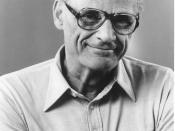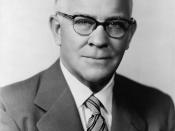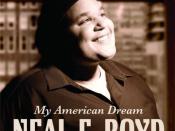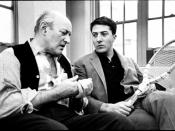How Willy Loman fits the definition of Arthur Miller's common man, How Linda is both the savior and destroyer of Willy, and how Willy relates to Jay Gatsby 1. In Arthur MillerÃÂs essay, ÃÂTragedy and the Common Man,ÃÂ he argues that the common man is just as appropriate as a subject for tragedy as people of noble status and higher ranks are. Willy Loman fits the definition of the common man as a tragic hero in Arthur MillerÃÂs essay in several different senses. First, Arthur Miller states that the common man must have emotional problems. This statement fits Willy because throughout the play he struggles with his emotions. Willy experiences guilt during the play because he is constantly reminded of the time that Biff found him with the woman in a hotel room in Boston. Willy knows that it was that experience that stopped Biff from finishing high school and going on to achieve his goals.
Willy is also disappointed that he never became the great success that he had always dreamed to be, further displaying his emotional problems. Arthur Miller goes on to say that the common man is capable of making errors. Willy Loman would like to believe that he is a successful, well-liked salesman. Willy said, ÃÂIÃÂm the New England man. I am vital in New EnglandÃÂ (Miller 32). It is the false belief about his success that gets him fired from his job in the long run. After being fired, he refuses the job that Charley offered him, which was a mistake. WillyÃÂs fantasies and dreams to be rich, loved, and admired by everyone lead him to making errors. Like the common man, Willy risks his life in order to secure his dignity. He commits suicide in order to free his family of his burden. Ultimately, Willy sacrifices himself to give freedom and hope to his family. He especially wants to provide Biff with a chance at success in the business world.
In Arthur MillerÃÂs essay, he maintains the idea that the common man has a desire to claim their identity, in which tragedy later occurs. Willy aspires to be like successful salesman, Dave Singleman. Dave Singleman, unlike Willy, was well-liked, attractive, and reached all of his goals. Willy seeks outside approval from others in an attempt to claim his identity. He wants a high social place to exist in his life. Furthermore, Willy is too pre-occupied with being well liked, which leads to his fear of losing the identity that he is struggling to attain. In Arthur MillerÃÂs essay it is stated that there is a possibility that the tragic hero can win. At points in the play, the audience has hope for Willy. When Willy plans to negotiate his job with Howard and there is the possibility of Biff getting a loan from Bill Oliver, the readers are led to believe that there could be a change and a possible victory for Willy. In addition, WillyÃÂs wife Linda has hope for him throughout the entire book and shows unconditional love toward him. MillerÃÂs six points that define the common man as a tragic hero each apply to Willy Loman.
2. As WillyÃÂs wife, Linda is simultaneously the savior and the destructor of Willy. Linda encourages Willy and is continuously supportive of him. She remains calm and patient with him and displays unconditional love through the good and the bad . As a support system for Willy, Linda felt responsible to not only take care of WillyÃÂs emotional and physical needs, but to reassure his doubts, boost his ego, and serve as a buffer between him and his sons, Biff and Happy. ÃÂGet out of here, both of you, and donÃÂt come back! I donÃÂt want you tormenting him anymore. Go on now, get your things together!ÃÂ (Miller, 98). When the boys do not respect their father, Linda always takes WillyÃÂs side, which brings out her unconditional love and support. As WillyÃÂs savior, Linda stood by him until the very end, up until his death.
On the contrary, Linda also contributed to the destruction of Willy. Although her absolute support was comforting to Willy, it dragged him further and further from reality. While supporting WillyÃÂs dreams of becoming rich and successful, Willy was becoming more distant from the real world and she helped him plant ideas in his mind that he would someday achieve these goals. She allowed him to exist in an unrealistic world. The safety net of support and comfort that she created for Willy led him to carry on an untruthful existence.
3.Willy Loman in Death of A Salesman by Arthur Miller and Jay Gatsby in The Great Gatsby by Scott F. Fitzgerald are comparably dominated by the American Dream, which ultimately destroys them. The lack of control of both GatsbyÃÂs and WillyÃÂs dreams lead to their downfalls. As tragic heroes who both believe in the American Dream, Gatsby and Willy sacrifice many things, such as their lives, for their families and loved ones. Willy Loman and Jay Gatsby carry out similar beliefs and views of the American Dream. While Gatsby is focused on gaining back his first love, Willy strives for himself, as well as his family, to become successful. Both Willy and Gatsby are stuck in the past. Gatsby wants to relive his past in hopes of winning Daisy back. Similarly, Willy seems to think that if he made different choices in his past that he could have prevented himself from becoming unsuccessful. ÃÂSure, sure! If IÃÂd gone with him to Alaska that time, everything wouldÃÂve been totally differentÃÂ (Miller, 31). WillyÃÂs older brother Ben, who made a fortune in Africa discovering diamonds, was a model for the success that Willy had dreamed of becoming. During WillyÃÂs flashbacks, he regrets not going to Alaska with Ben, who took a wrong route and ended up in Africa, discovering new riches.
Both characters have a symbol that represents their longing for the American Dream. In Death of a Salesman, WillyÃÂs desire for self-achievement and victory are depicted through Dave Singleman. Dave Singleman is WillyÃÂs ultimate role-model, a salesman who had everything that Willy wanted. He signifies Willy LomanÃÂs hope of the American Dream. In The Great Gatsby, the green light across the bay represents GatsbyÃÂs dream that he cannot achieve. The green light is a symbol of Daisy, whose love he cannot win. Willy and GatsbyÃÂs symbols focus on the failure of their American Dreams. Jay Gatsby and Willy Loman both dream of a profitable future as a reaction to the disappointment in their lives.





